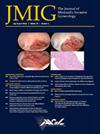深入了解绝经后无症状患者的诊室宫腔镜检查:822 例病例的适应症和结果。
IF 3.5
2区 医学
Q1 OBSTETRICS & GYNECOLOGY
引用次数: 0
摘要
研究目的本研究旨在评估无症状绝经后妇女转诊接受诊室宫腔镜检查时恶性肿瘤和其他子宫内膜病变的发生率,确定主要转诊指征,并评估其与恶性肿瘤风险的关系。次要目标包括评估超声变量与恶性肿瘤风险之间的关系,以及评估手术的有效性,其中包括诊室宫腔镜检查的持续时间、可行性和患者舒适度:设计:回顾性分析:研究在斯洛文尼亚最大的三级医疗中心卢布尔雅那大学医疗中心妇产科进行:队列由 822 名无症状的绝经后妇女组成,她们被转诊到诊室接受宫腔镜检查,但不包括去年绝经后出血的妇女:干预措施:参与者接受诊室宫腔镜检查,并进行或不进行活组织检查:宫腔镜检查的主要适应症是单纯的超声波异常,其余适应症包括超声波和临床发现。其中,97.4%为良性结果,2.6%被诊断为癌症或癌前病变。分析结果显示,与仅有超声检查结果的患者相比,根据超声检查和临床发现提示恶性肿瘤的患者发生恶性肿瘤的风险更高。在 387 名有超声变量记录的患者中,子宫内膜外观不均匀(OR:8.2,95% CI:2.4-27.9,pConclusions):在无症状的绝经后患者中,子宫内膜癌和癌前病变的发病率可能很低,大多数子宫内病变都是良性的。我们的研究表明,在没有特定风险因素的情况下,对这一人群进行常规子宫内膜监测的效用不大。在解释超声波检查结果时,考虑个体化评估和子宫内膜厚度以外的因素是至关重要的。本文章由计算机程序翻译,如有差异,请以英文原文为准。
A Deeper Look at Office Hysteroscopy in Asymptomatic Postmenopausal Patients: Indications and Outcomes of 822 Cases
Study Objective
This study aims to assess the prevalence of malignancy and other endometrial pathologies in asymptomatic postmenopausal women referred for office hysteroscopy (OH), identify main referral indications, and assess their relationship with the risk of malignancy. Secondary objectives included evaluating the association between ultrasound variables and malignancy risk and assessing procedure validity, which encompasses duration, feasibility, and patient comfort during OH.
Design
Retrospective analysis.
Setting
The study was conducted at the Department of Gynecology, Division of Gynaecology and Obstetrics, University Medical Centre Ljubljana, Slovenia's largest tertiary care center.
Participants
The cohort consisted of 822 asymptomatic postmenopausal women referred for OH, excluding those with postmenopausal bleeding within the last year.
Interventions
Participants underwent OH with or without biopsy.
Measurements and Main Results
The main indication for hysteroscopy was ultrasound abnormalities alone, with remaining indications including a combination of ultrasound and clinical findings. Among the cohort, 97.4% exhibited benign findings, while 2.6% were diagnosed with cancer or precancerous lesions. The analysis revealed that patients with indications based on ultrasound and clinical findings suggestive of malignancy had a higher risk of malignancy compared to those with ultrasound alone. In 387 patients with documented ultrasound variables, inhomogeneous endometrial appearance (OR: 8.2, 95% CI: 2.4–27.9, p < .001) and significant liquid content within the uterine cavity (OR: 10.2, 95% CI: 3.6–28.9, p < .001) exhibited strong associations with malignancy. Analysis of the procedure revealed a high feasibility rate (87.8%), with a median duration of 13.7 minutes and a median Visual Analog Scale pain score after the procedure of 3/10.
Conclusion
The prevalence of endometrial cancer and precancerous lesions in asymptomatic postmenopausal patients is likely low, with most intrauterine pathologies being benign. Our study demises the utility of routine endometrial surveillance for this population in the absence of specific risk factors. A holistic approach, considering individualized assessments and factors beyond endometrial thickness, is crucial in interpreting ultrasonic findings.
求助全文
通过发布文献求助,成功后即可免费获取论文全文。
去求助
来源期刊
CiteScore
5.00
自引率
7.30%
发文量
272
审稿时长
37 days
期刊介绍:
The Journal of Minimally Invasive Gynecology, formerly titled The Journal of the American Association of Gynecologic Laparoscopists, is an international clinical forum for the exchange and dissemination of ideas, findings and techniques relevant to gynecologic endoscopy and other minimally invasive procedures. The Journal, which presents research, clinical opinions and case reports from the brightest minds in gynecologic surgery, is an authoritative source informing practicing physicians of the latest, cutting-edge developments occurring in this emerging field.

 求助内容:
求助内容: 应助结果提醒方式:
应助结果提醒方式:


